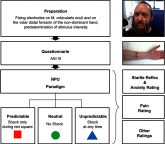Differential effects of experimentally induced anxiety and fear on pain: the role of anxiety sensitivity
- PMID: 31239757
- PMCID: PMC6559761
- DOI: 10.2147/JPR.S189011
Differential effects of experimentally induced anxiety and fear on pain: the role of anxiety sensitivity
Erratum in
-
Differential effects of experimentally induced anxiety and fear on pain: the role of anxiety sensitivity [Corrigendum].J Pain Res. 2019 Jul 10;12:2113. doi: 10.2147/JPR.S221053. eCollection 2019. J Pain Res. 2019. PMID: 31372028 Free PMC article. No abstract available.
Abstract
Background: Anxiety has been associated with both increased and decreased pain perception. Rhudy and Meagher (2000) showed that pain sensitivity is enhanced by anxiety (anticipation of shocks), but diminished by fear (confrontation with shocks). A problem of this approach is the confounding of emotional and attentional effects: Administered shocks (fear induction) divert attention away from pain, which might account for lower pain in this condition. Moreover, heterogeneous findings in the past might be due to inter-individual differences in the proneness to react to anxiety and fear such as ones anxiety sensitivity (AS) level. Objectives: Our aim was to clarify the association between anxiety, fear and pain. We used the NPU paradigm for inducing these emotions and recording pain sensitivity at once with one stimulus to prevent interference by distraction. We assumed that anxiety and fear affect pain differently. Moreover, we hypothesized that subjects with clinically relevant (high) AS (H-AS group) show enhanced pain perception in contrast to low AS subjects (L-AS group). Method: Forty healthy subjects (female: N=20; age M=23.53 years) participated and H-AS or L-AS status was determined by clinically discriminating cut-off scores of the Anxiety Sensitivity Index-3 (ASI-III). Emotions were induced by the application of unpredictable (anxiety) and predictable (fear) electric stimuli. Pain ratings of electric stimuli were compared between the conditions. Startle reflex and anxiety ratings were recorded. Results: Results showed no general effects of anxiety and fear on pain perception. However, anxiety enhanced pain sensitivity in H-AS subjects, whereas fear did not affect pain sensitivity. In L-AS subjects no effects on pain perception were found. Conclusion: Results revealed that anxiety, not fear, enhanced pain perception but only in subjects with clinically relevant AS levels. This indicates that subclinical AS levels are sufficient to increase pain sensitivity, in uncertain situations.
Keywords: anxiety sensitivity index-3; attention effects; electric stimuli; enhanced pain sensitivity.
Conflict of interest statement
The authors report no conflicts of interest in this work.
Figures




Similar articles
-
Counterirritation by pain inhibits the responsiveness to aversive loud tones: the role of state anxiety and state fear triggered in the NPU paradigm.Somatosens Mot Res. 2025 Mar;42(1):38-46. doi: 10.1080/08990220.2024.2322499. Epub 2024 Mar 9. Somatosens Mot Res. 2025. PMID: 38459928
-
Women, but not men, report increasingly more pain during repeated (un)predictable painful electrocutaneous stimulation: Evidence for mediation by fear of pain.Pain. 2012 May;153(5):1030-1041. doi: 10.1016/j.pain.2012.02.005. Epub 2012 Mar 7. Pain. 2012. PMID: 22401700
-
[Preliminary validation of the French translation of anxiety sensibility index-revised (ASI-R)].Encephale. 2003 Mar-Apr;29(2):157-64. Encephale. 2003. PMID: 14567167 French.
-
Fear-potentiated startle: relationship to the level of state/trait anxiety in healthy subjects.Biol Psychiatry. 1993 Apr 15-May 1;33(8-9):566-74. doi: 10.1016/0006-3223(93)90094-t. Biol Psychiatry. 1993. PMID: 8329489
-
Startle reactivity and anxiety disorders: aversive conditioning, context, and neurobiology.Biol Psychiatry. 2002 Nov 15;52(10):958-75. doi: 10.1016/s0006-3223(02)01665-7. Biol Psychiatry. 2002. PMID: 12437937 Review.
Cited by
-
The FRISK (Fracture Risk)-A New Tool to Indicate the Probability of Fractures.Int J Environ Res Public Health. 2023 Jan 10;20(2):1265. doi: 10.3390/ijerph20021265. Int J Environ Res Public Health. 2023. PMID: 36674018 Free PMC article.
-
Development and initial validation of the menstrual sensitivity index.Pain Med. 2024 Jan 4;25(1):78-85. doi: 10.1093/pm/pnad124. Pain Med. 2024. PMID: 37688582 Free PMC article.
-
Preoperative Anxiety Impact on Anesthetic and Analgesic Use.Medicina (Kaunas). 2023 Nov 23;59(12):2069. doi: 10.3390/medicina59122069. Medicina (Kaunas). 2023. PMID: 38138172 Free PMC article. Review.
-
Hypercapnia Reduces Perceived Heat Pain in Healthy Subjects.Eur J Pain. 2025 Mar;29(3):e70001. doi: 10.1002/ejp.70001. Eur J Pain. 2025. PMID: 39943895 Free PMC article.
-
Gender Difference in Pain Perception and Post-surgery Satisfaction Following Impacted Mandibular Third Molar Surgery - A Comparative Study.Ann Maxillofac Surg. 2025 Jan-Jun;15(1):2-8. doi: 10.4103/ams.ams_106_24. Epub 2025 Mar 24. Ann Maxillofac Surg. 2025. PMID: 40765871 Free PMC article.
References
-
- Ferreira-Valente MA, Pais-Ribeiro JL, Jensen MP. Associations between psychosocial factors and pain intensity, physical functioning, and psychological functioning in patients with chronic pain. A cross-cultural comparison. Clin J Pain. 2014;30(8):713–723. doi:10.1097/AJP.0000000000000027 - DOI - PubMed
LinkOut - more resources
Full Text Sources
Research Materials
Miscellaneous

